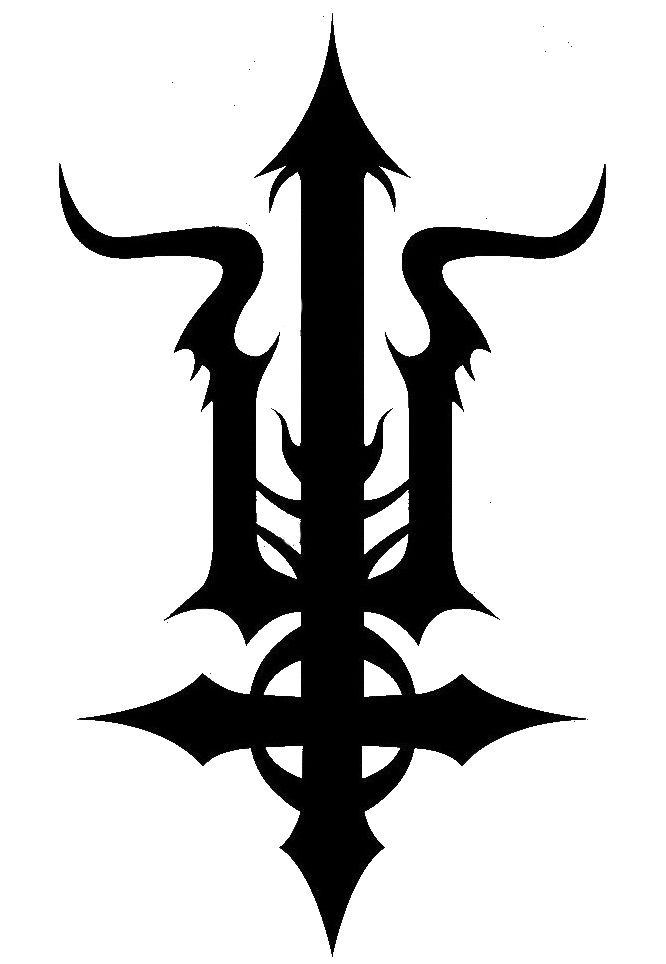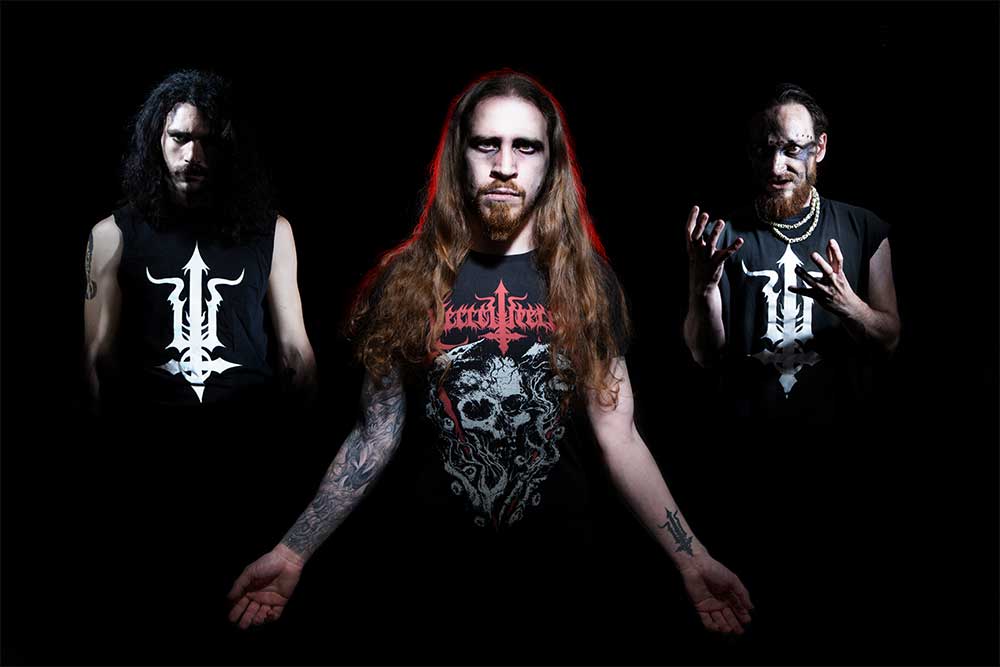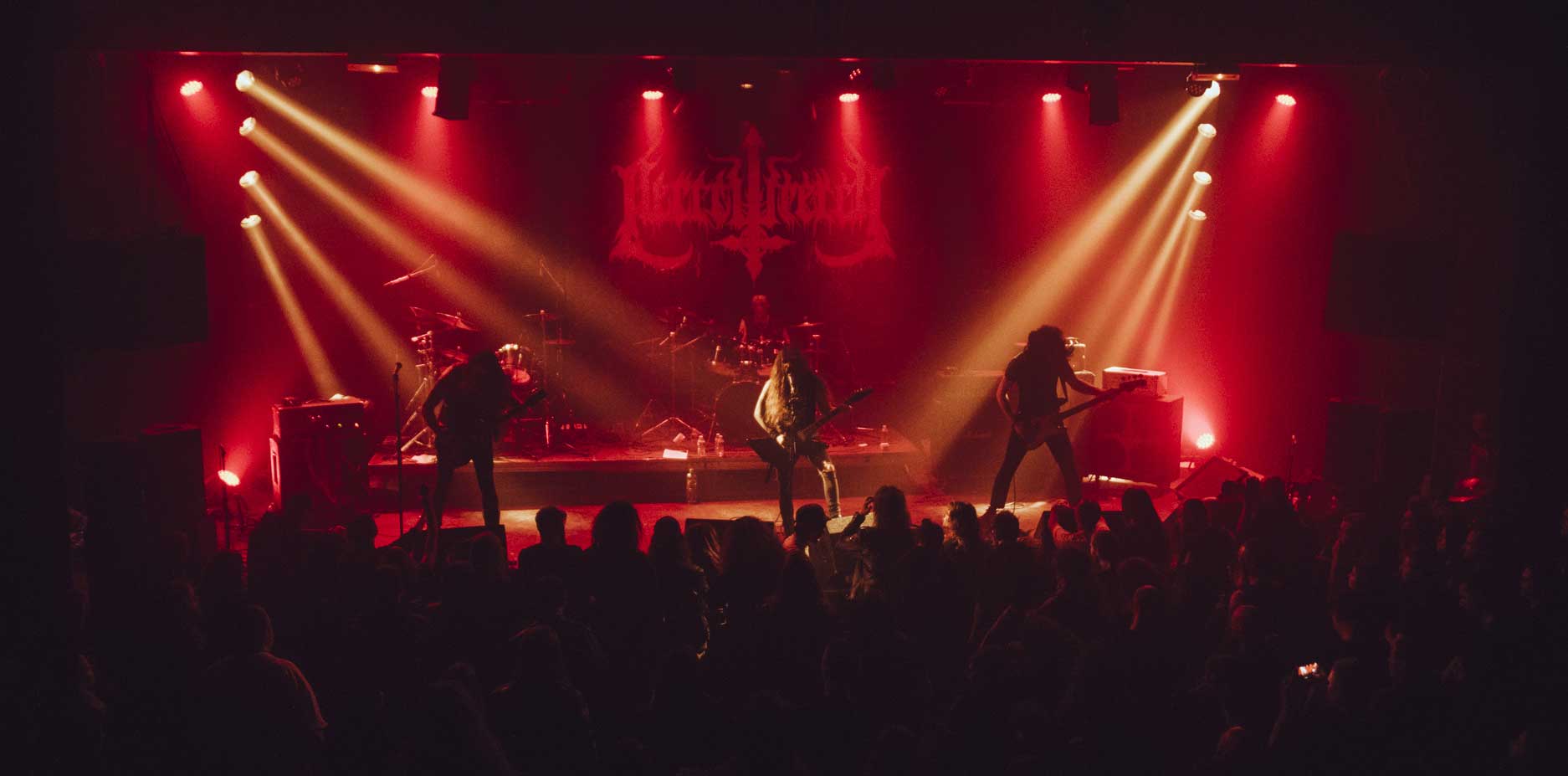Necrowretch
2020-09-16
by Niklas Göransson
French death metal band Necrowretch offers an eastwards trip with the Devil – from Berber dunes to Alevi-Ismailian fires. Founder and frontman Vlad discusses both touring and studying the shadow-side of the Orient.
– “The Ones from Hell” is without a doubt an offering for believers in the unlight – those who are able to comprehend what we’ve provided for them. “The Ones from Hell” is more than just a title; it stands as its own concept and refers to its creators as much as its servants. The album’s musical purpose isn’t to sound like others, but to wreak Hell unto the listeners and drown them in a lake of fire for the next thousand years. Therefore, any comparisons would be useless as our intentions belong only to us and our followers. As the gateway to Hell’s fire, it’s the first glimpse of a path intended to unleash our own evil signature upon the next decade.
NECROWRETCH ‘s fourth studio album, “The Ones from Hell” was released by Season of Mist in February 2020 – it comes three years after its predecessor, “Satanic Slavery”.
– Where “Satanic Slavery” was all about delivering thirty-five minutes of in-your-face death metal without respite, “The Ones from Hell” offers ambiences, tempo variations, bridges between songs, and a complete journey through the album. The sound of the drums is definitely the biggest change; you’ll notice how loud they are on this record. We went for a mix where drums and vocals occupied most of the space, with powerful-sounding toms. It’s not a very common mix choice, but we felt that “The Ones from Hell” had to have this almost tribal sound. When our mastering engineer, Alan Douches of West West Side Music, received the mix, he responded with something like, ‘If this front-of-house drum sound is intentional, the album will turn out great!’ These days, most records are produced in the exact same fashion – with a near-perfect sound on each instrument – but, in the end, all of them lack a soul of their own. Extreme metal should be uncompromising and unapologetic. If you feel that the music sounds sicker with everything in the red, then just do it! This album, from the writing process ‘til the mastering, was crafted with the intention of engulfing the listener in fucking fire. During the recording session, we realised how some of these new elements have made NECROWRETCH more NECROWRETCH than ever before, and we’re eager to unleash this bestial sound on upcoming shows.

Back in the days when performing shows was still possible, NECROWRETCH appears to have been hellbent on playing in all corners of the Orient. Not many Western bands visit places such as Malaysia, Taiwan, Vietnam, Korea, or the Philippines.
– We’ve been trading with maniacs from these countries ever since the demo days. After many years of emails and countless lost packages, we were able to start touring everywhere our music had both supporters and serious promoters. But while local interest and connections might’ve accelerated things, our strong craving to desecrate these lands would unquestionably have brought us there anyway. Even if metal music is still mostly common in Western countries, international travel is easier than ever before – which makes everything possible. However, one should not regard Asia simply as a ‘bonus tour’; interest has been growing in recent years, and some Western bands are now eager to include this region in their tour schedules.
What’s touring in these countries like?
– Damn crazy. The scene out of Asia is very young and fresh – there’s so much energy. People are still excited to go see a concert, whereas in Europe everything revolves around posing and taking selfies. You end up in a remote village at the end of the world, eating from fucking banana leaves in the stifling heat, followed by shitting in various shades of red. Then, come the evening, you’re up to play a satanic mass for an audience of true savages who congregate in an orgasmic buzz. The next day you spend hours sitting on flights, only to emerge in a different culture and here we go again: you cannot enter the backstage with your shoes on because it doubles as a prayer room. The promoter puts an impaled pig’s head in front of the stage for the entire evening before cooking it up for the bands’ after-show meal. Random chicken merchants outside the venue want to take a picture with you. Police throw your passport back in your face because you didn’t put any tip inside, and so on. This is the extreme flavour of metal that most European bands will never taste, because they’re too busy perfecting their flawless image of evil wolves that no one really believes. So, once more, hails to the beasts of the East!
In past interviews, Vlad has mentioned Turkey as an emerging hotspot for metal. The only previous band I recall discussing gigs over there with is Polish marauders INFERNAL WAR. Frontman Warcrimer mentioned ‘a group of real diehards from Kadıköy, a district of Istanbul that’s spawned several killer bands.’
– The scene from Kadiköy is very promising, as are some bands from Ankara. I regard the Turkish scene as the only mature one in the region – there is already a new generation coming to take the flame from the elders. Bands are releasing well-produced albums both through local and international labels, shows happen on a regular basis and are quickly filled up with diehards from Turkey, nearby countries, and even Europe. No doubt this place will slowly but surely make itself known within the map of extreme metal; we can already see some bands playing festivals and even tours in Europe. The list is very long but I’d like to mention Mezar Organisation, who twice brought NECROWRETCH to Turkey, as well as Hammer Müzik, – the place to be for both true metal and a true cup of tea.
In fact, Vlad has become so fond of the country that he spent a full year in Istanbul, whilst writing the new album.
– At first, I simply wanted to discover new horizons and take some time out of France. Istanbul, with its thousand-year-old history, quickly captured my full attention and made me feel right at home. I decided to pick up my guitar back in France and settle in Istanbul for a year, in order to write the album while taking Turkish courses. My time going between Europe and Asia has enriched me a lot on a personal level, but also musically. Away from everyday problems, immersed in a different culture, I was able to devote a great deal of my time to writing new material. It became a sort of solo-artist residency; a spiritual retreat, if you like. For the first two months, I didn’t so much as touch my guitar or even listen to metal. On the contrary, I was under a very strong influence of oriental music – and the local food, much like a character from Dune addicted to spice in search of eternal life. Then, without warning, the Evil One invited Himself and whispered in my ear the satanic verses I was instructed to transcribe through the disturbing arpeggios that, one year later, gave birth to “The Ones from Hell”.

Can you elaborate a bit about this composition process of yours?
– Well, it usually starts with a melody that I sing or whistle for a few days, before moving on to find the proper notes on guitar and writing them down on paper. Most of the time, this first riff will serve as a foundation for the whole structure of the song: variations, climax, chorus, etcetera. We often see clichés of musicians ‘working’ on new material with huge amps and a collection of booze, but this really isn’t the case for me. My inspiration comes from a state of consciousness I cannot enter in everyday life. I’m only able to summon this mind-frame from time to time, by surrounding myself with evil vibes from obscure music without any recognisable song patterns to cling onto. Walking naked is easier in the dark, and the same goes for music creation. So, in order to write a song about life and death, I usually sit down with a guitar – either an acoustic or unplugged electric – a notebook, and a litre of my own herbal tea infusion.
When working on music, Vlad drinks a traditional Moroccan beverage prepared from green tea, wormwood, mint, verbena, and orange flower water.
– While writing each part of the song, I also think simultaneously about the drum and bass lines – first I make them play in my head and then, later, write them with a MIDI software. From there I will send the song’s blueprint to the other band members, who might add some ideas for their own instrument. This process takes a lot of time, so I usually only work with one or two songs at once. The most important point is: if you can’t sing the riff, then you shouldn’t keep it. There can be no place for fillers or such tricks; the level of evilness needs to be at its maximum, all the time, even if this means simply removing repetitions or having fewer vocal parts. Better short than boring, and there’s nothing more boring than listening to a track for the first time and already knowing how it will go – be it from the artwork or the song structure. The Devil is not a guest, He comes by surprise and so should His music.
Speaking of which, in our pre-interview email exchange, Vlad told me he’s spent the last few years researching pre-Islamic conceptions of the Devil.
– I’ve always had an interest in studying and learning about these subjects – usually, the more obscure the better – and this trip with the Devil brought me from Berber dunes to Alevi-Ismailian fires. However, at first, except for some hidden references, I didn’t integrate my interest in these subjects to NECROWRETCH and instead stuck to the standard ‘anti-Christian’ lyrical themes. As both the band and my research grew, the direction steered into something more personal, more aligned with my roots and, therefore, my own interests.
Vlad grew up in France but is of Berber descent. The Berbers dominated Northwest Africa from the dawn of recorded history until the Islamic conquest of the 8th century. As tends to be the case in places subjected to Abrahamic annexation, there’s not all that much preserved from the indigenous religion, making it a somewhat frustrating affair to study.
– Vae Victis, woe to the vanquished – what’s done cannot be undone. Along with the Berbers, countless tribes and cultures have been ravaged, raped, destroyed, silenced, and wiped from the face of the earth all throughout history. The simple act of thinking for oneself can sentence entire cultures to doom, for mankind is an evil of itself and all power is granted to the victor. However, there are certain traits you cannot erase, phenomena bound to re-emerge for the same reason they arose in the first place. Other things will ultimately be forgotten by the very people that held them high as precious trophies of a glorious time long passed, and such is the cycle of civilisations. To me, this holds no frustration as the only world I belong in is the one I create for myself.

Vlad also mentioned that the two previous NECROWRETCH albums had ‘a lot’ of lyrical themes about topics such as Zoroastrianism and similar pre-Arabisation indigenous beliefs. Curiosity aroused, I inspected said lyrics but could not find a single reference to any of this. I had to stop reading and double-check with his email that I was studying the right band. I’m certainly no authority on these matters, so I must be missing some manner of subtlety here.
– The verses of our musical expression can indeed be rooted in Eastern mythology, even though it might not be immediately noticeable. For instance, one of our songs, “Tredeciman Blackfire”, was written as a satanic take on the largest sect of Shia Islam: the Twelvers. The lyrics for the title track of “The Ones from Hell” came to me naturally when researching ancient Zoroastrian poems, while “Pure Hellfire” is inspired by the eternal flame sanctuaries such as Yazd and Atəşgah as well as their corruption by the forces of evil. There are many references and interpretations all throughout our work and while I could list them to you one by one, our goal is not to write lyrics riddled with references that require specific knowledge to digest and understand – nor is it to transform our albums into theological lectures. Walking the path of wisdom, one should always search for one’s own understanding. A verse should be strong and simple enough to be meaningful and powerful for anyone with an interest in the dark arts, regardless of cultural background. If you grew up in a strongly biblical society, you may interpret the same lyrics differently than someone from Yezidi heritage – who may himself interpret it differently from what I originally intended, but, ultimately, the inherent message remains the same. In any case, we don’t intend for our music to become art for the elite, or to be eaten with silverware. It is pure satanic death metal and will remain an apocalyptic eruption of hellfire, spawned by Satan’s hate.
When you say that these cultures also ‘believed in the Devil’ – do you mean they had some kind of theologically adversarial character in their pantheon?
– More than simply searching for Satan’s name in different languages, my research made me aware of how and when the Devil became a part of human beliefs. While it is indeed true that most later cultures have a form of Devil in their pantheon, some sects or castes within these cultures have been worshipping the Devil exclusively. For example, Ahriman – the Zoroastrian ‘King of Darkness’, believed to be the prototype of the Judeo-Christian Satan – was worshipped by the Druguvanti, Yatukan and Karapan cults, who all sought wisdom through the primal darkness of the black flame. Such sects of ‘sorcerers’ and devil-worshippers are not unique to Persia, as there are numerous examples… from the Olmec sacrifices in present-day Nicaragua to the Mangkukulam in the Philippines.
Mangkukulam is a term used for someone who practices kulam, an ancient form of Filipino folk magic typically employed for acts of malice – it was highly prevalent before the Spanish colonisation and remains so to this day, especially in the hinterlands and rural areas. Its application is typically to inflict some manner of ill fortune: bad luck, disease, injury, or even death. In order to combat attacks of such kinds, one turns to the various shamans and faith healers associated with indigenous Filipino spirituality. The two counterparts uphold a similar balance to that seen in Amazonian shamanism; those who use plant magic for mischievous means are called brujos, or sorcerers, whereas the healers are known are curanderos.
– What makes cults such as the Druguvanti interesting is their quest for ascension: by understanding the Adversary as more than a mere concept, and truly following Him, they seek the freedom to ultimately become their own god through the wisdom of dark arts. In that aspect, they may have been among the first of what you today would call a theistic satanist. Another interesting note about the Zoroastrians is that their mythology was itself likely derived from the Indo-Aryans scrolls of the Rigveda. Upon arriving in Persian territories during intense tribal wars in the Achaemenid, the Ahrimanic demonic forces were added and may therefore have been the first layer of evil in a previously demon-less pantheon. Some say that the evil arcanes were taught to mankind by the Devil, but did man invite the Devil or did the Devil invite Himself?



